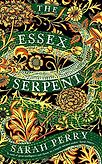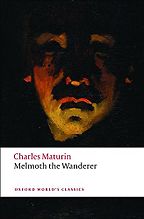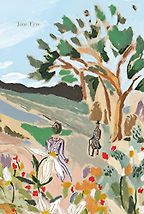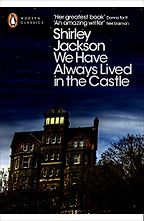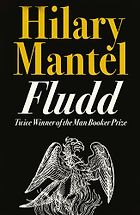Tell me about the Gothic tradition.
I was surprised to discover that I was considered to be writing in the Gothic tradition with my first book. I thought the Gothic was rather absurd stories of girls in nightgowns running away from villains. But once it’s been suggested to you you write in a certain way, you can’t help but become self-aware. So, my PhD became about the Gothic, and I began to study it and realise I was writing in a Gothic tradition and I started to embrace it and to love it.
I was brought up in a very strict religious background. The idea of sin and transgression and something out there, a darkness, had been very much part of my formative years. I think the Gothic is a way of dealing with that.
You said in your Aeon essay that the Gothic is an irresistible space for lots of readers. What makes it irresistible?
There’s two things here. One of them is the way the Gothic works is to put a kind of delicious flesh on the bones of our darkest and most nebulous impulses and fears. Take Dracula for example. You have this simultaneously wicked and tragic, repulsive and attractive character, who is an embodiment of desire and power and degradation. That enables us to imprint on this utterly compelling character our own darkest desires, obsessions, and impulses. This encoding of all our own desires is where the true Gothic lies.
The other — this is a guiding principle for me in my writing — is a line from Melmoth the Wanderer. Halfway through the novel the narrator turns to the reader and says, “Emotions are my events.” In real Gothic fiction, the events that are really important are the emotions that are evoked by the reading. The reader is as much a character as any of the fictional characters in the book because they’re so affected by it: moved to dread, terror, and repulsion. That’s why the Gothic is so irresistible.
It’s creating a safe space in which you can feel all these extremes.
I think so. Take The Monk, which has an incestuous relationship in it. It’s not a book that will only appeal to you if you’ve had incestuous desires. The fact the novel is about something so transgressive, and about it in a way that is so delicious and rather thrilling, enables people to examine their own furtive feelings in a way that is rather pleasant. It’s quite a dangerous genre, and of course we’re all drawn to things that are a little bit dangerous and not very good for us.
So, we know readers find the genre pleasurable, but as someone who writes it what are the impulses and pleasures of it like for you?
They’re twofold. A lot of it is unconscious. I think of the Gothic not as a genre, but as a feeling or a tradition. Genre fiction, which I admire enormously, has rules. A genre practitioner will understand these rules and either exploit them or choose to subvert them. If you’re writing in the crime fiction tradition there are conventions and rules that define that genre. It’s the same with romantic fiction, or fantasy, or sci-fi. With the Gothic, it’s really hard to pin down what the rules are, because it comes back to this feeling, this sensation.
You can’t say a book is a Gothic novel because something supernatural happens, because in some of the very best and purest Gothic fiction you can’t say if the supernatural is there or not. In The Turn of the Screw it’s impossible to come down on the side of demon possession or sexual abuse. You can’t say Gothic fiction is always full of slightly medieval, romantic story-telling and fables, like in The Castle of Otranto, because some Gothic fiction isn’t like that. You can’t say all Gothic fiction has a maiden in peril, or a villain. So when I write, it’s more that I happen to inhabit this space, and happen to see the world in that way. I find a strangeness and a darkness in things, probably because of my upbringing, a feeling that brimstone is never far from the soles of my feet and that there’s more to the world than neurons firing and atoms and molecules.
While I’m writing I’m constantly thinking about the reader’s experience. When I was writing The Essex Serpent there were some scenes in it where I was very keen that the reader be encountering the terrible and the sublime, very important elements of Gothic feeling. When I wrote After Me Comes the Flood, its first title was Confusion. I wanted the reader to be as confused as the main character. The guiding principle for me is that I want the reader to feel the terror, and the awe, and the strangeness that the characters do.
Your first book is Mary Shelley’s Frankenstein. Why did you choose it?
It wasn’t published till 1830, but she had the idea and wrote the story when she was nineteen years old, 200 years ago, in 1816. The reason this book is so vitally important to me is that it is a permission-giver. In my formative time as a writer I felt the burden of expectation of the kind of book that a young woman, living in Hackney in the 21st century, should be writing. I thought I should be writing some sort of thoughtful, semi-autobiographical, poignant, sharp, taut book, rigorously realist, about the life of a young woman. And I didn’t want to write that, I didn’t want to write about myself. I wanted to push language to beautiful extremes, I love adjectives and adverbs and descriptive writing. I found myself torn between what I thought I was expected to write, and what I wanted to write.
What Frankenstein does is blow all of that out of the water. Any ideas of writing in a modest way, or in a fashionable way, are gone. Frankenstein has a reach of imagination that is almost hysterical. She was able to pluck this idea both from her imagination and her understanding of science. She understood what Erasmus Darwin—Charles Darwin’s grandfather—was doing: experiments with electricity and the re-animation of dead objects. She was fantastically well-read, she was terribly intellectual, she was a political radical. She had no truck with modesty and restraint, or doing what was expected of her. She was going to let her imagination go as far as it possibly could. Then she defended it. In the years afterwards people would say to her, ‘It must have been those guys you were hanging out with that gave you the idea, it must have been something to do with your husband.’ And she said, ‘No, it was me, I had this dream, and I woke up and wrote it down.’ I think it’s so important for women writers and for new writers to have a text that is a talisman, showing what they can do. There’s a bucking the trend, a kicking against the pricks, destroying novel conventions and pushing it as far as it will possibly go.
This is a book where she essentially dispensed with God. The creature is made. He isn’t born in original sin, he is an innocent being. It’s an extraordinary work of sci-fi that turns all received wisdom upside-down. I look at this nineteen-year-old girl and I think, ‘We should all be so brave and courageous.’ She shows that Gothic fiction and these kinds of parables can also be deeply profound. Just because you’ve come up with a monster doesn’t mean you’re not also writing about politics and about the way we live now. You can do both.
Can you talk more about the idea of the monster being born without original sin?
One of the things that’s really striking about Frankenstein is the way she deals with the idea of innocence and transgression. We think of the creature as being this monster, and indeed he is by a certain number of definitions: he looks monstrous, he is evidently terrifying in his aspect, and he strangles a young boy to death and subsequently kills quite a few other people. And yet, this is not shown as being an inevitable consequence of his conception. Traditional theology would say that man is born in sin, the heart of man is deceitful above all things and you must be saved and redeemed and forgiven.
Here it’s the other way round. He’s totally innocent. He is a living embodiment of innocence and goodness and he is subsequently degraded by the humans he meets. It’s a really daring thing to do, to say someone could be born in total innocence and when they do wicked things it’s because of what has been done to them and not because they were born in sin. It’s radical. Obviously, her husband, Percy Bysshe Shelley, was an atheist, and she’d been very alert and alive to these radical ideas around her. She took them on board and gave them flesh.
Your next choice is Melmoth the Wanderer.
This is my favourite book and I can never find anyone who’s read it. When I do I just want to embrace them. It was published in 1820, and it was written by Charles Maturin, an impoverished Irish vicar. To me, it is the embodiment of Gothic fiction. It does everything that a Gothic novel should do. It is darkly funny, it has a grim gallows humour, it is utterly terrifying. I’ve made a habit of reading quite a lot of scary and horrific books, but there are places in Melmoth the Wanderer where, when I read it, I actually have to put my hand over the page because I cannot look at the words. There is no Stephen King book, no James Herbert book that can touch Melmoth the Wanderer for horror. It’s atrocious.
It has an extraordinary villain, Melmoth, who is a supernatural being who has evidently entered into some kind of Faustian pact. He’s damned to wander the earth for hundreds of years. He tries to find people who will exchange places with him. On his wanderings, he encounters people at the lowest ebb of life and experience, because only if you are at the nadir of your life would you exchange places with a damned soul. So this incredibly clever structure enables Maturin to have episodes of storytelling in scenes of wartime, in the Spanish Inquisition, in lunatic asylums. It has a fantastic love story as well. Melmoth is fabulously sexy, and rather tragic, and falls madly in love, and has sex with a lightning storm! It has a narrative complexity that I find thrilling, with layers of embedded narratives and fragments.
Like Frankenstein, it’s a permission-giver. It shows a novelist not to be modest, not to say, ‘This is a coincidence too far, this plot is too daft, nobody would believe it for a minute.’ Well, actually, what we do when we read novels is suspend our disbelief as high as it will go and you can get away with enormous amounts.
Charles Maturin died in poverty. It’s extraordinary that he could have written this amazing book, that’s so influential, I don’t think he ever knew the impact it would have.
Balzac was a fan, and he had others?
Interestingly, Oscar Wilde was one of his descendants, and when Wilde signed himself into hotels, he would sign himself ‘Melmoth’, which I find really exciting.
You’ve said it’s very difficult to characterise the Gothic as a genre. It contains science, or ghost stories explained and here there’s a Faustian pact. What happens in the Gothic when the devil actually appears?
There’s a really interesting bit of narrative theory around this. Tzvetan Todorov, the critic, said that there are three layers of narrative in the Gothic. There is the layer of the ‘fantastic’, which is the outright supernatural, and Melmoth is the ‘fantastic’ because it’s evident Melmoth is a supernatural being. He has a telescope that enables him to view things all over the world, he’s lived for 150 years, and so on. Then there’s the ‘marvellous’, which is stuff that seems to be supernatural, but it’s pretty clear by the end of the book that it’s actually in your mind. Ann Radcliffe’s work fits into this category. She tends to chicken out at the last minute and you realise there’s nothing supernatural going on. But then suspended in the middle is the ‘uncanny’, and that’s where I think some of the best Gothic fiction lives, where you never really know whether something supernatural has happened and there is a ghost or a ghoul or the devil, or whether everybody’s mad. The Turn of the Screw is the peerless example of this. You cannot tell whether it’s supernatural, or in her head.
That’s the space I have tried to inhabit, and am trying to with the book I’m working on at the moment: to leave the reader in a state of confusion where they’re not sure whether they’ve encountered demons, or whether the characters are absolutely off their heads.
The later books I’ve chosen fall in the ‘uncanny’ and the ‘marvellous’, rather than the ‘fantastic’. I’ve tried to choose a range of books that show the Gothic can be all of those things: a ghost story, or a story about madness.
Let’s talk about Jane Eyre and how that fits in.
Jane Eyre is not true Gothic, I don’t think. But it has elements of the Gothic in it. Brontë has a mad woman in the attic and hysterical laughing, and a servant drinking her bottle of port and saying, ‘You don’t need to worry about it,’ and the bed being set on fire, and all this terrible stuff that quite easily fits into the Gothic. But there’s more. The scene early on where Jane as a child is locked into the Red Room is proto-Freudian. She’s returned to the womb, and is born again when she’s released, but she’s born into a slightly different state of being. Her mind has been altered by visions of the ghost of her dead uncle. That scene shows impulses operating on the child’s brain in the same way that reading Gothic fiction would operate on someone. It plays with your perception and changes the way you see the world. It births Jane into this space where she’s able to think the unthinkable, and say the unsayable. She’s able to be brave.
There’s another amazing scene towards the end, after her abortive marriage, after she’s found out who the mad woman in the attic is, after she has run away. She hears Rochester calling. It wasn’t until my third reading of the book that I realised Brontë had slipped the supernatural into Jane Eyre. It’s called the ‘mysterious summons’. She’s walking out in the rain and she hears him. He’s miles and miles away and she cannot have heard him, yet she does, and it’s the beginning of her returning to him.
I think the book exemplifies the fact that you can write what is effectively a piece of realist fiction, but at the same time include enough of the Gothic feeling to turn it into something richer and stranger. I find that really exciting. You don’t have to go all out to write a Gothic novel. There’s elements of the Gothic feeling that can be used to enrich and to make slightly more strange and more seductive whatever you’re writing.
Next is We Have Always Lived in the Castle, by Shirley Jackson.
This is a masterpiece in atmosphere and Gothic empathy. By that I mean that the Gothic draws out your love for the characters who in the abstract shouldn’t have your sympathy at all. It’s narrated by Merricat Blackwood. The Blackwoods live in this tumbledown house in large but dilapidated grounds. Merricat does strange magic spells, the family are ostracised by the villagers. They’re this self-contained, strange little unit. It’s absolutely rich with all this suppressed female sexuality, and the enormous power of a young woman: a young teenage woman poised between childhood—the odd practices she still has and her love for her cat and so on—and the power of the adulthood she’s about to enter. At all times you’re aware that a great crime has been committed, a great tragedy. And you gradually find out where that lies and where it comes from. By then, your emotions and sympathies are engaged to such an extent that you’re forced into being complicit. That’s what I find exciting about it. It challenges your idea about what wickedness is and who you can sympathise with. It’s incredibly clever. Shirley Jackson was an absolute master of playing with the reader and poking and teasing them, and pushing them further and further.
She wrote in the sixties in America; our last book was in the 1840s in England. What is she doing with the Gothic tradition?
She’s been very clever. She has a habit of being very subversive about small-town America as a microcosm of the whole country. She’s famous for “The Lottery”, a short story, which, when it was published in The New Yorker, received more complaints than any other short story they’d published before. In it, she depicts a small, modern, ordinary American town where everybody knows each other and it turns about as dark as a short story can get. What she’s saying in all her fiction is don’t think you are civilised or safe, with your refrigerator and your white picket fence, and knowing the next door neighbour but one, and walking your dog in the morning, because underneath this veneer of healthy teeth and orange juice for breakfast, we’re all kind of savage, and there’s a magic out there, and you could turn on each other at the drop of a hat. That’s really radical.
A space outside the civilised seems to be a coherent definition of the Gothic as a genre. It’s exciting to think about it in this context of small-town America and picket fences.
That’s one of the reasons I found We’ve Always Lived in the Castle so exciting. So much of the Gothic fiction I had read had been set in places we conventionally think of as Gothic: the Yorkshire Moors, Melmoth travels from rural Ireland to Spain, Ann Radcliffe’s novels are set in Italy and the Alps. It’s exciting when you pluck the Gothic from those sublime mountain backdrops and deep labyrinths underneath castles or abbeys and drop all of that feeling, that sensation, those transgressions, that terror, into something ordinary and workaday. This is why Fludd and the work of Hilary Mantel is so important, because she does for suburban England what Shirley Jackson did for small-town America. If you’re English and more familiar with English towns, that’s even more thrilling.
Shall we talk about Fludd? Why did you choose this book?
This is the book I wish I had written of all the contemporary novels I’ve read. It’s set in the fifties, in a small, rainy Yorkshire town. The local Catholic church is still very old-fashioned, and the priest receives a letter saying someone’s going to come along and shake you up. So he is expecting someone to come along and guide them into the 20th century, and one dark and stormy night there is a knock on the door, and standing on the doorstep is a priest with a neat little dog collar and his black hair combed very tidily. It soon becomes apparent that this is a form of the devil.
It’s absolutely extraordinary because you have, in the slightly suspicious small Yorkshire town, this fantastically seductive and sexy and villainous priest character who sets about causing havoc. But you can’t really loathe and despise him, because you want the havoc to be caused. There’s an amazing scene where he seduces a nun, and he removes one-by-one the pins that hold her wimple to her hair.
It inhabits that place we were talking about between the marvellous and the fantastic. It’s in the uncanny. For much of it, you’re never really sure whether you’re seeing this interloper through the eyes of the mistrustful villagers, who would be inclined to see anybody shaking things up as being little devilish, or whether he actually is the actual devil. It does that great Gothic thing of playing with your emotions and sympathies. You should be shocked and appalled, but you really want him to seduce a nun in a bed and breakfast.
The loss of Catholicism is at the centre of the English Gothic. Can you talk about the religious confusions behind Gothic fiction?
I think what the Gothic does is provide a space where we are able to explore strangeness and wonder, what the critic Rudolf Otto called the numinous, this feeling that there is something beyond the comprehension of the intellect, something sublime, strange and wonderful. We want to explore it away from the rigours either of organised religion or science. I know why it’s so important for me. I am in a post-religious state, effectively. I had this very rigorously structured religious background. For the first twenty years of my life, I was a Biblical fundamentalist, who had faith, but a faith written out like a manual. It’s very hard to explain to people how you can have a faith that’s not strange, that’s not supernatural. You read the Bible like a manual for operating a piece of machinery. So you believe in the divine being, but strangeness and mystery have been removed from it all because everything’s been explained.
I’m now in a state post that, where I don’t have that religious feeling, and I don’t have that religious practice, and yet I still feel that there is something that can’t be accounted for by atoms, and neurons firing in my brain. The Gothic enables me to explore that feeling away from the structure of religion. I think that’s one of the important functions of the Gothic.
What is your impression of the Gothic novels, like yours, that are being written now?
I have a theory that the Gothic thrives in the immediate aftermath of a trend towards absolute certainty. The first blooming of the Gothic—starting with Walpole’s The Castle of Otranto at the end of the eighteenth century—came in the wake of the Enlightenment. The Enlightenment started to make the strange unstrange, the inexplicable understandable. So there’s a blooming of the Gothic. Then in the nineteenth century, we have Darwin and the Industrial Revolution, and another era of rationality, of people becoming amateur naturalists. In the wake of scientific discovery, the Gothic has another booming with Dracula and The Island of Dr Moreau, and the mid-to-late-Victorian Gothic.
Now we have new atheism, this rather strident, insistent, against-strangeness and suddenly the Gothic is appearing again. It’s as though it’s always there at the moment when people are keen to retrieve the strange, the wonderful, the fantastic, and the sublime from an attempt to explain everything away. When I first started studying the Gothic for my PhD in 2009, there wasn’t much in the way of contemporary Gothic fiction being written. I’m seeing more and more of it now, Andrew Michael Hurley’s The Loney being a superb example. Lucy Wood’s The Weathering is another. I wonder whether it’s always going to be there as a recourse for those who are slightly repulsed by an attempt to explain everything away.
Five Books aims to keep its book recommendations and interviews up to date. If you are the interviewee and would like to update your choice of books (or even just what you say about them) please email us at [email protected]
Five Books interviews are expensive to produce. If you've enjoyed this interview, please support us by donating a small amount.

